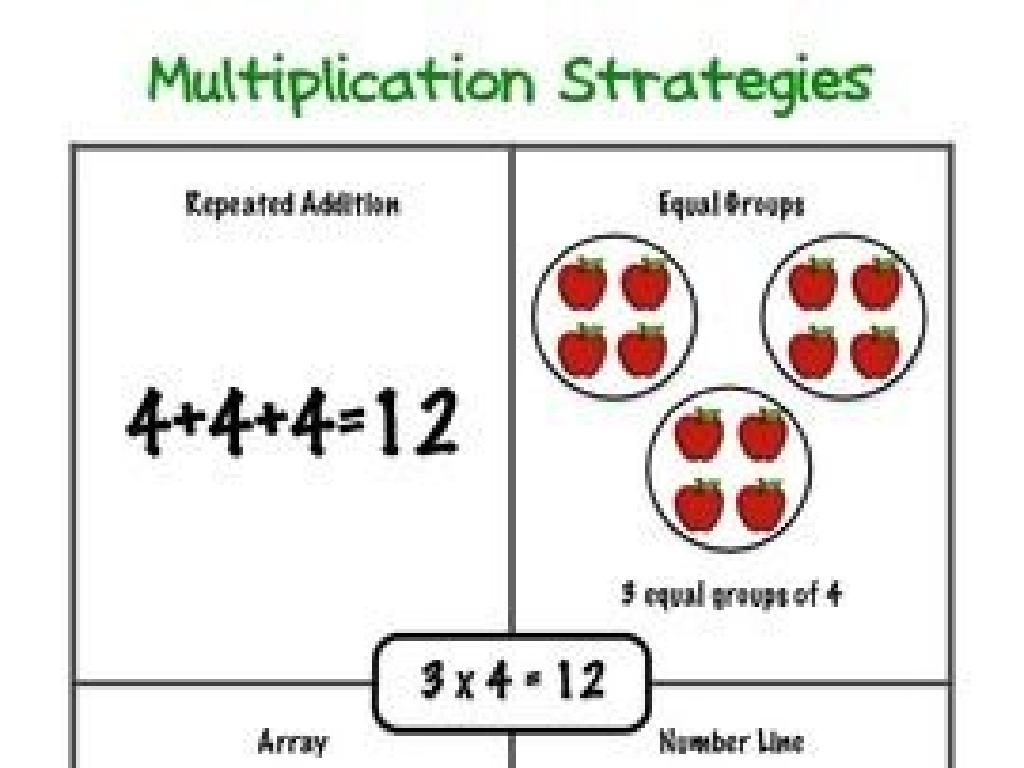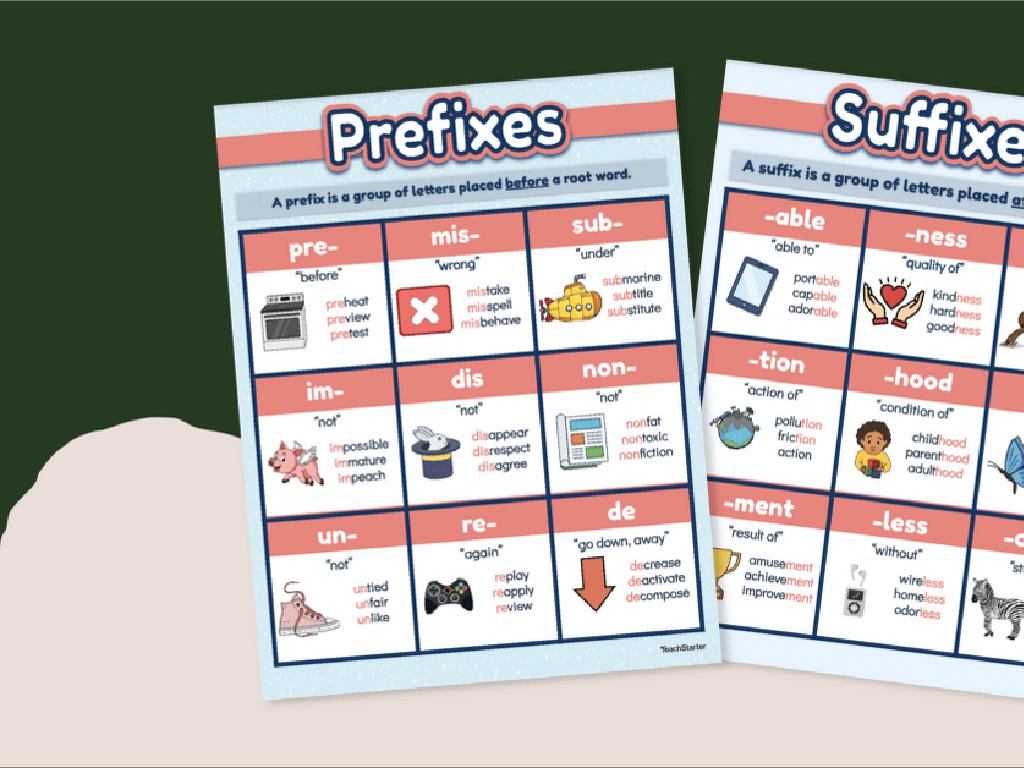Form And Use Plurals: Review
Subject: Language arts
Grade: Sixth grade
Topic: Nouns
Please LOG IN to download the presentation. Access is available to registered users only.
View More Content
Plural Nouns: Singular vs. Plural
– What are singular nouns?
– A singular noun represents one item, e.g., ‘dog’, ‘child’, ‘city’.
– Transition to plural nouns
– Plural nouns represent more than one item, often adding ‘s’ or ‘es’, e.g., ‘dogs’, ‘children’, ‘cities’.
– The role of plurals in sentences
– Plurals show quantity and affect verb agreement in sentences.
– Importance of correct plural forms
– Using the right plural form ensures clear communication and grammatical accuracy.
|
This slide introduces the concept of plural nouns to the students, contrasting them with singular nouns. Start by explaining that a singular noun denotes one single entity, while plural nouns are used to indicate more than one. Highlight common rules for forming plurals, such as adding ‘s’ or ‘es’, and exceptions like irregular plurals. Emphasize the importance of using the correct plural forms to maintain clarity and avoid confusion in both written and spoken language. Provide examples and encourage students to think of their own examples of singular and plural nouns. Discuss how plural nouns affect the verbs in sentences, reinforcing subject-verb agreement rules.
Understanding Nouns: A Quick Review
– Define a noun
– A noun is a word for a person, place, thing, or idea
– Nouns represent many things
– They can be tangible like ‘pencil’ or intangible like ‘idea’
– Examples: cat, school, pencil
– ‘Cat’ is an animal, ‘school’ is a place, ‘pencil’ is an object
– Abstract nouns like ‘happiness’
– ‘Happiness’ is a feeling, not something you can touch
|
Begin with a refresher on what a noun is, ensuring students can identify nouns as words that name people, places, things, or ideas. Provide clear examples that students can relate to, such as common items in a classroom or emotions they experience. Emphasize the difference between concrete nouns (like ‘cat’, ‘school’, ‘pencil’) and abstract nouns (‘happiness’), which represent things that cannot be experienced with the senses. Encourage students to think of their own examples and to understand that nouns form the foundation of sentences and are crucial for expressing clear thoughts.
Singular vs. Plural Nouns
– Singular nouns: one entity
– Refers to a single person, place, thing, or idea
– Plural nouns: multiple entities
– Indicates more than one, often by adding ‘s’ or ‘es’
– Example: ‘dog’ vs. ‘dogs’
– Singular: ‘One dog’, Plural: ‘Two dogs’
– Forming plurals: rules & exceptions
– Most nouns add ‘s’, but watch for special cases like ‘child’ to ‘children’
|
This slide introduces the concept of singular and plural nouns, which is fundamental in understanding noun usage. Emphasize that singular nouns refer to one item, while plural nouns refer to more than one. Use common examples like ‘dog/dogs’ to illustrate the point. Discuss the basic rule of adding ‘s’ or ‘es’ to form plurals, but also highlight that English has irregular plurals that do not follow this rule. Encourage students to think of other examples and to be aware of irregular plural forms. This will prepare them for activities involving sentence construction and noun agreement in number.
Regular Plural Forms
– Plurals with -s or -es
– Hiss sound: add -es
– Words ending in ch, sh, x, s, z form plurals by adding -es
– Example: bus -> buses
– When a word ends in ‘s’, like ‘bus’, we add ‘es’ to make it ‘buses’
– Example: witch -> witches
– ‘Witch’ ends in ‘ch’, so we add ‘es’ to make it ‘witches’
|
This slide reviews the rules for forming regular plural nouns, which is a foundational concept in grammar for sixth-grade students. Start by explaining that most nouns in English become plural by simply adding an ‘s’ at the end. However, for nouns that end with a hiss sound like ‘ch’, ‘sh’, ‘x’, ‘s’, or ‘z’, the rule is to add ‘es’ to form the plural. Provide the examples ‘bus’ and ‘witch’ to illustrate the rule. Encourage students to come up with more examples and write them down. This will help reinforce their understanding of regular plural forms and prepare them for more complex noun forms.
Irregular Plural Forms
– Nouns with unique plurals
– Not all plurals end with ‘s’ or ‘es’
– Examples: Child to children
– ‘Child’ changes to ‘children’, not ‘childs’
– Mouse becomes mice
– ‘Mouse’ changes to ‘mice’, not ‘mouses’
– Some nouns remain the same
– ‘Sheep’ is both singular and plural
|
This slide focuses on irregular plural forms, which are exceptions to the regular pluralization rules. Emphasize that while most nouns in English form the plural by adding ‘s’ or ‘es’, some nouns have irregular forms that must be memorized. Provide examples such as ‘child’ becoming ‘children’ and ‘mouse’ becoming ‘mice’ to illustrate the point. Also, highlight that some nouns do not change at all when they are plural, like ‘sheep’ and ‘species’. Encourage students to think of other examples and to understand that these irregularities are part of what makes English a rich and diverse language. Instruct them to practice by writing sentences using both the singular and plural forms of these irregular nouns.
Special Spelling Rules for Plurals
– Nouns ending in -y: ‘y’ to ‘i’ + -es
– Example: ‘baby’ becomes ‘babies’
– Nouns ending in -o: add -s or -es
– ‘photo’ becomes ‘photos’, ‘potato’ becomes ‘potatoes’
– Nouns ending in -f/-fe: change to -ves
– ‘leaf’ becomes ‘leaves’, ‘knife’ becomes ‘knives’
|
This slide reviews the special spelling rules for forming plurals in English, tailored for sixth-grade students. Emphasize the transformation of nouns ending in -y by changing ‘y’ to ‘i’ and adding -es, such as ‘party’ to ‘parties’. For nouns ending in -o, explain that some just add -s, like ‘photo’ to ‘photos’, while others require -es, like ‘potato’ to ‘potatoes’. Lastly, discuss the change from -f or -fe to -ves with words like ‘leaf’ to ‘leaves’. Provide additional examples and encourage students to come up with their own. Practice exercises could include identifying the correct plural forms and creating sentences with plural nouns.
Practice Time: Forming Plurals
– Practice forming plurals
– Add ‘s’ or ‘es’ to make most nouns plural
– Class collaboration on examples
– We’ll solve examples as a group activity
– Understand rules for regular nouns
– Most nouns just need an ‘s’, like ‘cats’ or ‘dogs’
– Explore exceptions and irregular nouns
– Words like ‘child’ to ‘children’, ‘mouse’ to ‘mice’
|
This slide is designed for a class activity to practice forming plurals. Start by explaining the general rule of adding ‘s’ or ‘es’ to make most nouns plural. Engage the class by working through examples together, reinforcing the concept of regular plural nouns. Then, introduce the concept of irregular nouns and their unique plural forms. Provide a variety of examples and encourage students to come up with their own. The activity should be interactive, allowing students to discover patterns and exceptions in plural forms. This will help solidify their understanding of how to form and use plurals in their writing and reading.
Class Activity: Plural Scavenger Hunt
– Find classroom items for plural forms
– Work in pairs to list plurals
– Share findings with the class
– Reflect on the activity
– Discuss the different plural rules you used
|
This interactive activity is designed to help students apply their knowledge of forming plurals in a fun and engaging way. Have the students roam the classroom to identify various objects, then write down their plural forms. Encourage them to work in pairs to foster collaboration. After completing their lists, each pair will share their findings with the class, which will help reinforce their understanding of plural nouns. As a reflection, discuss the different rules for forming plurals, such as adding ‘s’, ‘es’, or changing ‘y’ to ‘ies’. This will also be a good opportunity to address any irregular plurals they encountered. Possible variations of the activity could include finding items in a book, on a website, or in a magazine.
Conclusion & Homework: Plural Nouns Practice
– Excellent work on plural nouns!
– Homework: 10 sentences with plurals
– Use nouns with different plural endings
– Recall rules for various endings
– Examples: ‘buses’, ‘wolves’, ‘cherries’
– Be ready to review in next class
|
Students have done a great job understanding the concept of plural nouns. For homework, they are tasked with writing 10 sentences that include plural nouns, ensuring they apply the rules for different endings such as ‘s’, ‘es’, ‘ies’, etc. This will help reinforce their understanding of the topic. In the next class, we will review their sentences together, which will provide an opportunity to correct any misconceptions and celebrate their successes. Encourage creativity and the use of a variety of nouns to demonstrate their grasp of the pluralization rules.






